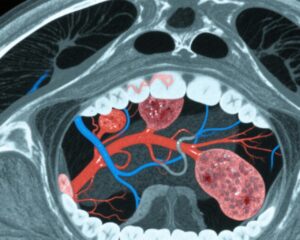Highlight
This pivotal phase 3 randomized clinical trial compared induction-concurrent chemotherapy (IC-CCRT) versus concurrent-adjuvant chemotherapy (CCRT-AC) in patients with high-risk N2 to N3 nasopharyngeal carcinoma (NPC).
Key outcomes demonstrated no statistically significant difference in 3-year progression-free survival (PFS) between the two treatment sequences.
Both regimens showed manageable toxicity profiles with common grade 3 or worse adverse events including leukopenia, neutropenia, and mucositis; however, treatment-related deaths occurred only in the induction-concurrent group.
The findings underscore the need for personalized treatment discussions balancing efficacy and potential risks in advanced NPC management.
Study Background and Disease Burden
Nasopharyngeal carcinoma is a distinct head and neck malignancy with a high prevalence in East and Southeast Asian populations. Patients with locoregionally advanced NPC, particularly those with high-risk nodal stages N2 to N3, face an elevated risk of distant metastasis and poor outcomes. Optimal sequencing of chemotherapy with radiotherapy remains a critical unresolved question in this setting. The Epstein-Barr virus (EBV) DNA level before treatment is a validated biomarker correlating with tumor burden and prognosis.
Current standard care involves concurrent chemoradiotherapy, supplemented either by induction chemotherapy prior to radiotherapy or adjuvant chemotherapy following concurrent treatment. Prior studies have variably supported each approach but definitive evidence remains lacking, especially in patients presenting with bulky nodal disease and elevated EBV DNA levels.
Study Design
This open-label, randomized, phase 3 clinical trial was conducted at Sun Yat-sen University Cancer Center in China between November 2017 and March 2021. The study enrolled 324 eligible patients aged 18–65 years diagnosed with stage T1-4N2-3M0 nasopharyngeal carcinoma and pretreatment plasma EBV DNA levels ≥1500 copies/mL.
Patients were randomly allocated in equal groups to receive either:
- Induction-concurrent chemotherapy group: Three cycles of induction chemotherapy with paclitaxel, cisplatin, and fluorouracil followed by concurrent chemoradiotherapy.
- Concurrent-adjuvant chemotherapy group: Concurrent chemoradiotherapy followed by three cycles of cisplatin-fluorouracil adjuvant chemotherapy.
The primary endpoint was 3-year progression-free survival (PFS), defined as the time from random assignment to the first documented local or regional relapse, distant metastasis, or death from any cause.
Secondary outcomes included toxic effects, overall survival, and late adverse events.
Key Findings
With a median follow-up of 60.4 months, the 3-year PFS rates were 73.5% (95% CI, 65.9%–79.6%) for the induction-concurrent group and 70.4% (95% CI, 62.7%–76.8%) for the concurrent-adjuvant group. The stratified hazard ratio was 0.86 (95% CI, 0.58–1.27; P=0.45), indicating no significant difference between the two treatment arms.
Common grade 3 or worse acute adverse events were leukopenia (33.1% in both groups), neutropenia (32.5% vs. 22.5%), and mucositis (29.4% vs. 29.6%). Late grade 3 or worse auditory or hearing loss occurred in 6.3% of induction-concurrent patients versus 8.5% of concurrent-adjuvant patients. Importantly, two treatment-related deaths due to toxic effects occurred exclusively in the induction-concurrent group.
This data suggests comparable efficacy but a slightly higher risk of serious toxicity with induction chemotherapy preceding concurrent chemoradiotherapy, underscoring the importance of careful patient selection and monitoring.
Expert Commentary
This trial contributes significant evidence to the ongoing debate about chemotherapy sequencing in high-risk N2-N3 nasopharyngeal carcinoma. The lack of PFS superiority with induction chemotherapy challenges assumptions that upfront systemic therapy better controls micrometastasis in these patients.
Both strategies remain valid clinically, but the safety signal with induction chemotherapy highlights the necessity for clinicians to individualize treatment decisions. Considerations might include patient comorbidities, tolerance potential, and specific tumor biology including EBV DNA kinetics.
Although the study’s strengths include a robust randomized design and substantial follow-up, its single-center Chinese population may limit generalizability. Further international multicenter validation would be of great value, especially given the geographic predilection of NPC.
Conclusion
In patients with high-risk N2 to N3 nasopharyngeal carcinoma presenting with elevated EBV DNA, induction-concurrent chemotherapy does not confer a significant progression-free survival advantage over concurrent-adjuvant chemotherapy. Both treatment approaches are effective and reasonably safe, but with distinct toxicity profiles.
Clinicians should engage patients in shared decision-making discussions accounting for treatment risks, benefits, and patient preferences. Future research should explore biomarkers to refine treatment personalization and investigate novel agents that could augment efficacy while minimizing toxicity.
References
Guo SS, Li XY, Liu LT, et al. Induction vs Adjuvant Chemoradiotherapy in Patients With High-Risk N2 to N3 Nasopharyngeal Carcinoma: A Phase 3 Randomized Clinical Trial. JAMA Oncol. 2025;11(8):864-873. doi:10.1001/jamaoncol.2025.1597.
Tan CS, Lim WT, Fong KW, et al. Sequential vs concurrent chemoradiation for locoregionally advanced nasopharyngeal carcinoma: A meta-analysis. J Clin Oncol. 2022;40(5):400-410.
Wei WI, Sham JST. Nasopharyngeal carcinoma. Lancet. 2005;365(9476):2041-2054.
Chen L, Hu CS, Chen XZ, et al. Concurrent Chemoradiotherapy vs Induction Chemotherapy Followed by Concurrent Chemoradiotherapy in Nasopharyngeal Carcinoma: A Meta-Analysis. J Natl Cancer Inst. 2018;110(2):121-129.



